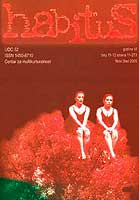Elementi multikulturalnosti u povijesti vojvođanskih gradova
Elements of multiculturalism in the history of vojvodinian citiest
Author(s): Slaven BačićSubject(s): Cultural Essay, Political Essay, Societal Essay
Published by: Centar za multikulturalnost
Keywords: multiculturalism; history; Vojvodina; Middle Europe; Western Europe; the history of Habsburg time in Vojvodina; orthodox community in Vojvodina
Summary/Abstract: Even though multiculturalism became in the XX century as a theoretical and practical concept in the democracies of Western Europe, many element existed before that time in Middle Europe, with Vojvodina as a part of it. Th is very period had many examples of what we nowadays call intercultural and multiculturalism. However, the researches of the history of Habsburg time in Vojvodina is not just few, but almost regularly limited by the national, black and white paradigm. It seams useful to remind ourselves of some legal and factice solutions in the legal-historic formation of the three biggest vojvodinian cities- Novi Sad, Sombor and Subotica. Feudal states were class societies in many ways. The only three cities of Vojvodina that had the status of a free city were Novi Sad, Sombor and Subotica. Th e city hall of these three cities consisted of 13 members, chosen from the representatives elected by the members of the existing religious communities. Th e cause of different regulation of confessional membership in the free cities of Vojvodina was due to their different religious structure. In Subotica of 1779, for example, the orthodox members were only about the eight of the whole population, having no larger importance for the life of the city. However, there is no mention about the number of some confessions participation in city hall of Novi Sad and Sombor. Interesting practice was developed in Subotica despite the legal regulation. During the consensus in 1779 the 38 members of orthodox community had been declared offcials. Later on this number increased in the town management. Soon the first Protestants in Novi Sad got the citizenship, yet their representatives for the magistrate were chosen in the 30-ies of the XIX century. When we talk about the Greco Catholics, they are purely mentioned as the way of the offcial formalism. The decay of feudal system and the war of 1848/49 in Hungaria, in which the members of two biggest confessions of the three cities were confronted, opened a new chapter in the history of these cities and the Middle Europe as a whole. Due to the war, even Vojvodina is often stated as the ethnically various and tolerant space, the many traditional elements of multiculturalism were oft en endangered with different projects of ethnic engineering, especially in the XX century. The chain of events proved that the multiethnic societies are more a practice in the feudal societies, that is, until the political rights are reserved just for the certain parts of society.
Journal: Habitus
- Issue Year: VI/2005
- Issue No: 11-12
- Page Range: 185-192
- Page Count: 8
- Language: Serbian

